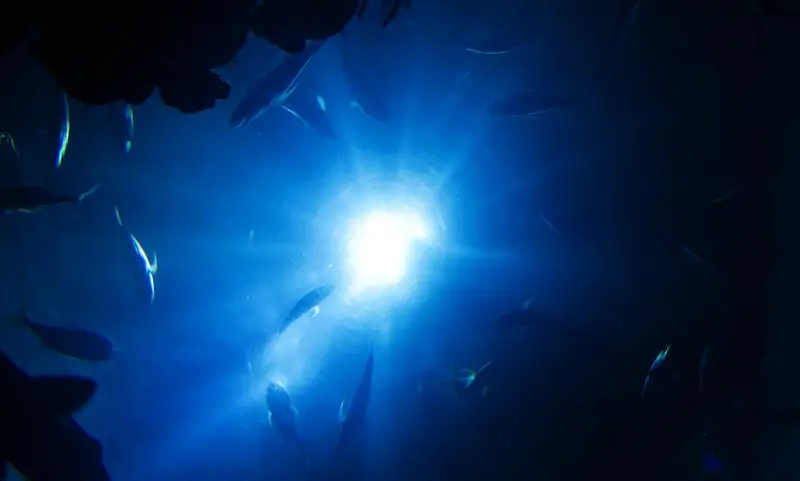
Let me just start by saying this: You probably don’t need a flashlight for snorkeling. I mean, most people prefer to observe fish and coral on a sunny day with pleasant weather conditions. However, some people prefer to go “night snorkeling“. I’m not a big fan of that since I prefer to spend the evenings in a cozy restaurant. Many fish species become active at night. They search for food and enjoy the cool water temperature (in summer months, fish can feel quite “hot”). So I agree, it must be awesome to do that sometime. It does however take some precautions like safety and experience.
So why do I have a snorkel flashlight? Even though I don’t use it that much, it can be helpful. If you’re a fanatic snorkeler like myself, you probably remember those days when all of a sudden clouds started to appear. If it’s your only day of snorkeling for the time being, that could be disappointing. I once dedicated an entire article about snorkeling in the rain, which usually involves clouds as well. Having a flashlight could make a big difference, especially if you just discovered that underwater kingdom you’ve been dreaming about for ages.
In this article I will share a simple and efficient snorkel flashlight that I sometimes use myself (remember, it’s not that often). I’m not a flashlight expert! But it’s a fun gadget to have.
Things To Consider
Size / Weight
This may seem obvious, but it’s really something to think about. Let me give you an example. When I go snorkeling, I often combine the day with some hiking. At most times I need to bring my snorkel backpack. And yes, that fills up pretty fast (especially when you go snorkeling with kids). Not that one single flashlight makes or breaks your day, but think outside of the box. If you bring 10 pieces of equipment, and they all are light-weight, you could end up with way less luggage to carry around.
Ease Of Use
Dealing with too many things at once isn’t the best strategy for snorkeling (if you ask me). I try to simplify things as much as possible. I usually go for one of these 2 options: I either have my GoPro attached to my full face snorkel mask, or I attach my flashlight to one of my regular snorkel masks. That way I have either a flashlight or a camera in one of my hands, and I use my other hand to move around. For darker days I usually prefer to have my flashlight on my mask, because the light will always follow the direction of my face. Furthermore, pay attention to switching your flashlight on and off, and if it’s easy to change between angles.
Lumen
As a fanatic photographer, I wouldn’t go below 500-600 Lumen. But of course, it all depends on “how dark” it’s out there. A lower amount of Lumen could be just fine whenever there’s still some sunshine and whenever clouds aren’t too bad. The more Lumen, the more powerful your beam. This is great for objects in the distance, but could also be annoying for objects nearby. Too much light isn’t always fun, especially for photographers.
Angle
Think of it this way: If you use a small angle, you usually have a “sharper” light beam with further reach. Good for objects in the distance. If you use a wide angle, the beam doesn’t light up the distance that well, but a larger area will lighten up. If you ask me, this is great for photography.
Battery
Go for something that suits you best. I usually stick with the “old fashioned” batteries, but you could just as well go for something with an internal battery that you can charge through USB for example. Just remember that switching regular batteries can be of help whenever you’re out of power and there’s no nearby power source for recharging.
Price
Since I don’t use my flashlight that much, I personally wouldn’t spend a lot of money on one. But that could be totally different for you. However, it’s a delight to have a good quality light source whenever you need it. I spent about 50 bucks on mine, which isn’t cheap at all, but the pictures I was able to make with it are priceless.
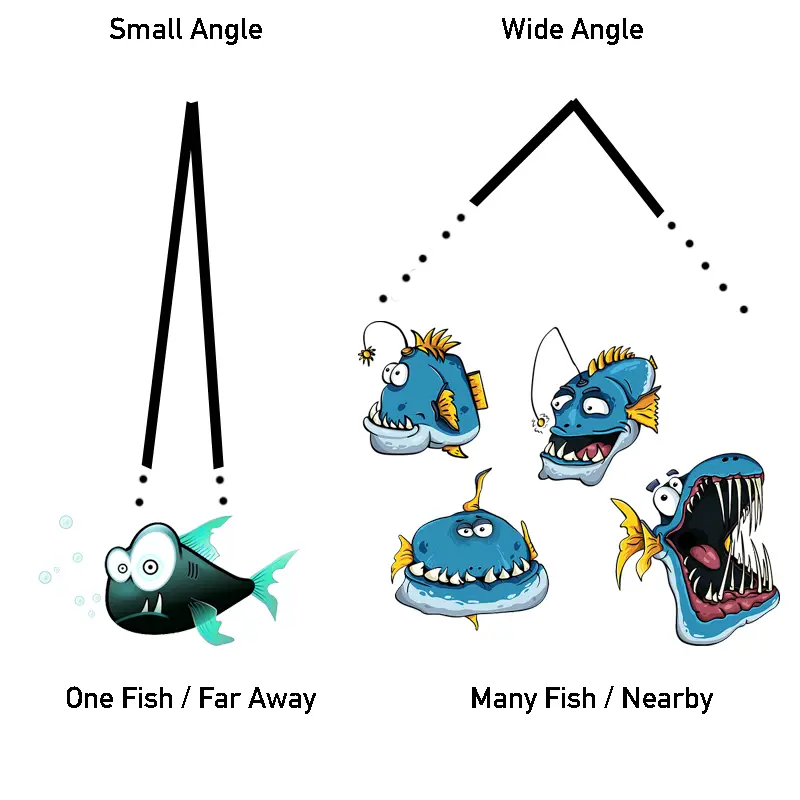
So Which Snorkel Flashlight Do I use?
I use one by Orchatorch, and it’s not even 4 inches in length! But it does the trick for me just fine. Gear that I occasionally use has to be small so I don’t need a beach cart to carry everything around. And this flashlight is just the perfect size for me.
There are different models, but I use the 630 Lumens version. I usually have the beam on 60 degrees (you can set it to 15 degrees as well).
The best part is, I’m able to attach it to my snorkel mask. As some of my readers already know, I’m a big fan of snorkeling with a GoPro. Having your hands free to film or move around is of big importance to me. And if I position the flashlight towards the front, it follows the movements of my head.
You can set the angle to narrow or wide, even though I always leave it on wide because it’s not that dark anyway. It just makes the whole scenery a little more visible, especially when clouds aren’t too bad.
I know that many gadgets run on some kind of internal battery that you can recharge, sometimes even through USB. However, I always prefer the “normal batteries” because I can replace them whenever there’s no power source around to recharge. Just a sidetone: This is not advise, just my own way of dealing with gear. Yeah, maybe I’m a little old fashioned.
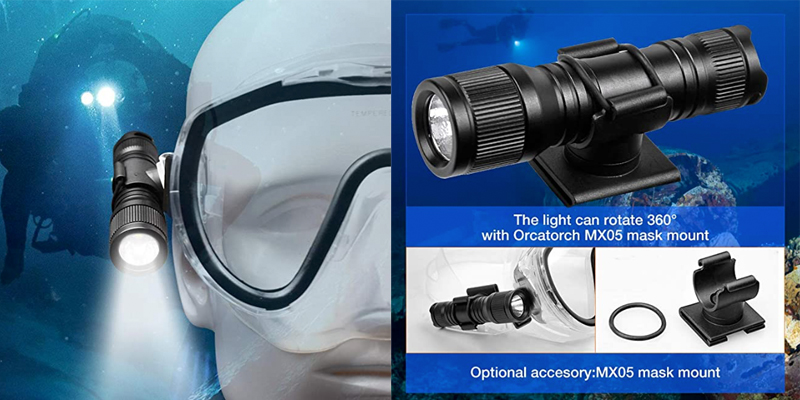
If you’re interested about all the details (I’m not the expert), you can find my flashlight at Amazon here.
Snorkel Flashlight Inspiration
Best Bang For Your Buck ($15)
So what else is out there? A lot actually. So let me share some gear to possibly check out yourself. Links are below the pictures.
Here’s a super bright flashlight with a maximum of 1100 Lumen (there are 3 settings). There’s no snorkel mask attachment clip but if you don’t mind holding your gear then this could work just fine. You can attach it to yourself by using the cord, or maybe you carry some kind of snorkel bag or case. You can switch this gadget between 3 different modes.
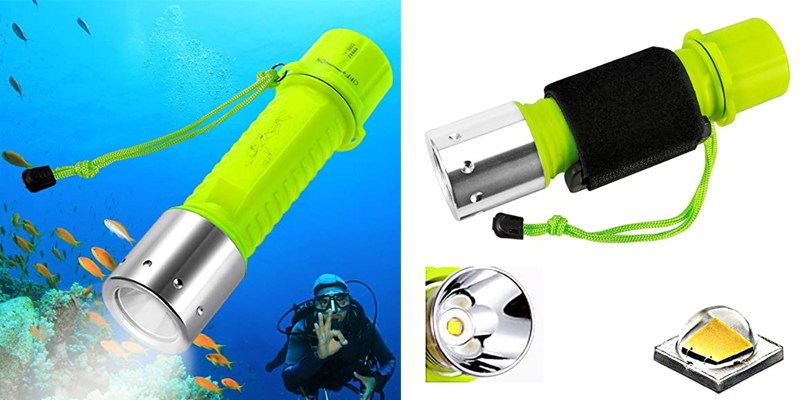
More details and order options at Amazon can be found from this link.
Pretty Professional – Adjustable Brightness ($40)
Yup, some of this gear seems to be pretty much “scuba” proof. And we might not need all of that. But well, you never know. And there’s nothing wrong with grabbing a flashlight that’s able to help you out up to almost 500 feet deep. I myself do scuba dive, but only when the weather is good and with an instructor. Anyway, this light will probably help you out big time. You can adjust the Lumen between 300 – 1000.
When you stay afloat whilst snorkeling, the bottom of the ocean can sometimes be a little far away. If you need a flashlight that’s able to brighten up these deeper areas, who knows this scuba/snorkel flashlight is more than enough.
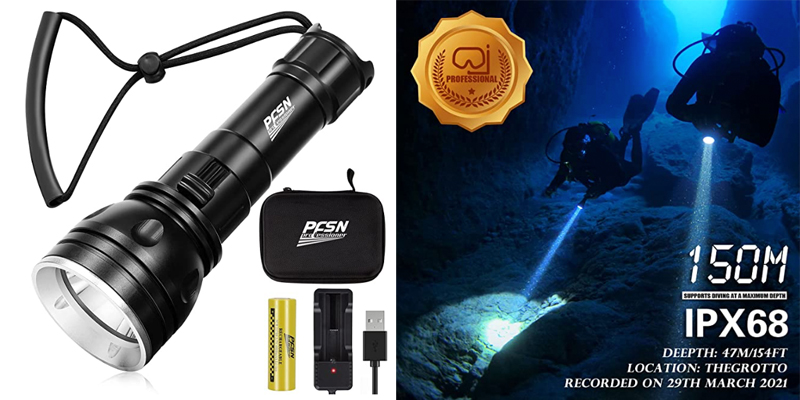
More details and order options at Amazon can be found from this link.
Shine Like A Boss ($100)
This 6000 Lumen flashlight can be the real deal if you need a heavy duty light below the ocean surface. However, too bright isn’t always big fun! Sure, it’ll work great to observe deeper areas, but when you move around you’ll probably run into some nearby objects. Now that could be disturbing! Imagine shining 6000 Lumen towards a reef that’s just in front of you…you’re not going to have a good time!
Luckily you’re able to adjust the amount of Lumen (which is why I actually like this flashlight). You can set it to as low as 350 Lumen. 2 other options are 900 and 2000 Lumen. So, depending on the area and the amount of natural light, you’ll be able to select one of these 4 settings to make sure the amount of light matches your surroundings. Another pro is the rechargeable battery that’ll provide 5 and a half hours of light (I suppose that’s the case when using the 900 Lumen setting).
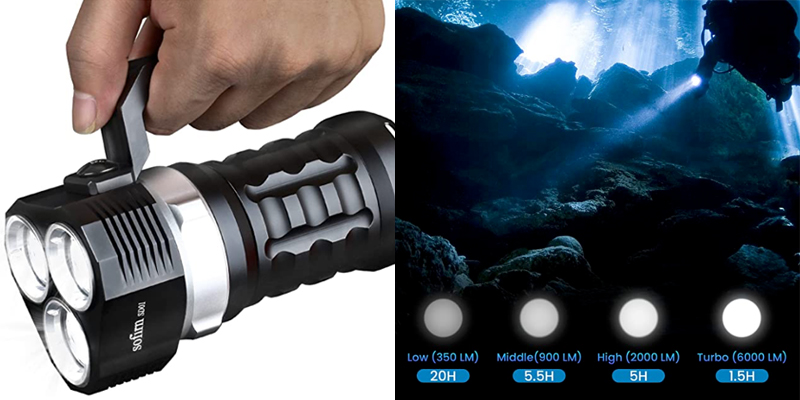
More details and order options at Amazon can be found from this link.
Final Thoughts
If you’re a fanatic night snorkeler, you probably know more about flashlights than I do. However, if you’re like me and you feel the need for a flashlight every now and then (or to own one just in case), maybe this beginner guide has been of sufficient help. I personally prefer to have around 600 Lumen with a wider beam, because I usually stay close to objects and because I use my camera a lot. However, Lumen and angles are a personal choice. Maybe you need something totally different (again, this is my personal preference).
